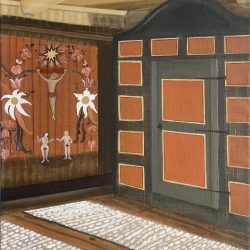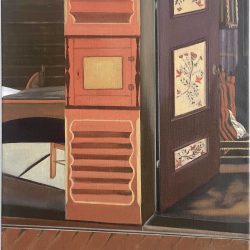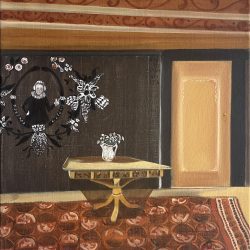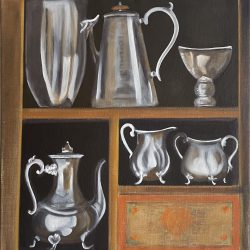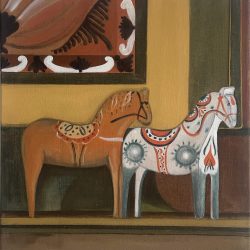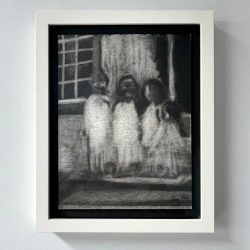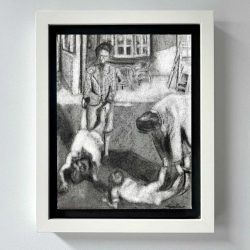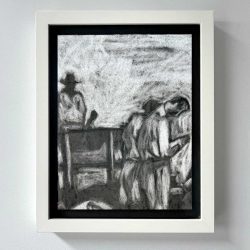Tori Beeche | Dream Bird
22 June – 10 July
Tori Beeche deftly manipulates visual and material culture to create works that are nostalgically astute and optically glorious. Curious souvenirs, ceremonial objects and decorative patterns fill these grand domestic interiors which have all been carefully captured by Beeche’s diversified practice. Combining the familiar and imagined, she presents and explores the artifice of constructed spaces, languages of fragmented time and a mysterious discourse of cross-cultural, deliberately juxtaposed, relationships.
Beeche’s new exhibition Dream Bird continues to mine family narratives for reference material to paint. The exhibition title takes its name from a quote by the German cultural critic and media theorist Walter Benjamin (b.1892, d.1940) who said:
“Boredom is the dream bird that hatches the egg of experience”.
For Tori, childhood bouts of boredom were alleviated by her father’s entertaining stories from his past, often centered around the history of his family and the many decorative objects in her family home. His narratives were weaved around the rituals and symbolic objects of his childhood, not only quelled boredom – they passed on cultural heritage in way that we don’t seem to do much anymore.
This entertainment ritual Tori had with her father, is now enacted out in her painting practice. The psychological canvas of daydreaming and paternal storytelling, now a real canvas on which to project fantasies, emotions, ways of life and try to arrange them in a useful narrative.
The subject matter for Dream Bird references objects and places that have been saved for future generations. Asking us to consider what marks objects or places of such cultural significance to someone that they feel a responsibility to preserve them for the future. And how can these precious archived items be of use to these future generations. With the disappearance of many of the rituals that these objects were used in, they are now redundant. Today they are stored out of sight and never engaged with. They are photographed, digitizing them for permanence, but we are losing contact with the physical objects and the communities and connections that are built around them.
Cultural theorist Byan Churl Han writes how the combination of our drug like dependency on technology and a disappearance of traditional community bonds has led to many today suffering afflictions of isolation, loneliness and depression.
The contemporary world offers multiple ways to avoid boredom. If we choose, every spare moment can be occupied with some form or other of digital entertainment. But with this constant flow of media, Han believes people are experiencing a temporal crisis, their experience of time speeds up and is full of fractured narratives, with no specific end points to rest at. No time to consider and process what they have seen or to daydream about what it all might mean for them and their loved one. But for Benjamin the psychological state of boredom was useful, and Tori sees the truth of this. It was the instances of boredom from her childhood that lead to periods of unstructured daydreaming, time to reflect on the social conditions in which we live and consider in what sense they could be made better.
Beeche utilises the suggestion of nostalgic recall to explore how our memories are linked to the objects we attribute meaning to and the physical places we occupy – and how these artifacts and spaces shape our understanding of the world. Her paintings formulate a spatial dimension from the social, emotional, and aesthetic narratives the spaces we live in hold. Foucault talks about space as the experience of being drawn out of ourselves and into space as our journey through life occurs. We have absorbed the influences the rooms of our childhood contained, and the spaces we create as adults can hold our worldview. It is a critical reflection on the past that incorporates nostalgia. At the heart of it is the idea of a detour, which suggests unexpected exploration and encourages the recovery of unforeseen pasts. The idea of a detour sends us off to explore side-shows and back-alleys rather than following the straight road of forward progress that has been the narrative of the twentieth century. Looking back to find a way forward. The re-presentation of the past is a certain kind of political statement; a call for us to re-value the past and learn from these rediscoveries.
